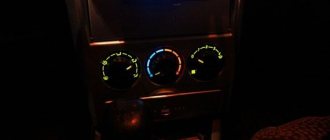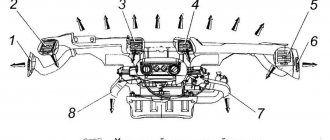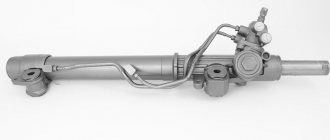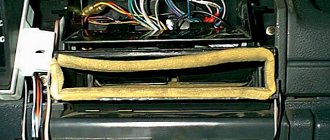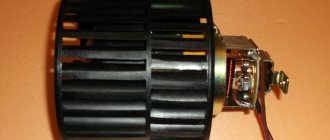Cold heater at idle rpm may be due to the following reasons - low coolant level in the expansion tank, the formation of an air lock in the engine and/or heater cooling system, faulty water pump, clogged radiator and some others. In most cases, the car owner can independently get rid of the problem when the heater blows cold at idle. To do this, you will need to check the cooling system, or rather the operation of some of its elements.
Assessing the reasons or why the heater may stop blowing warm air
As it turns out, even a lack of antifreeze in the tank causes the engine to heat up and the heater to blow cold air from all the grilles. More trivia:
- The damper that determines the path of outside air entering the cabin is jammed.
- The stove faucet does not work.
- The heater radiator is clogged.
Serious reasons are associated with problems in the engine cooling system:
- The thermostat is stuck.
- The pump failed.
- The cylinder head gasket is broken.
The nodes may be fine, but unnoticeable accumulations of air in a small or large circuit can shape the weather. In the automotive environment, they are called air jams, and the process itself is airing.
How to flush a car heater radiator
You can flush the heater radiator either on the car or with removal. At the same time, removing such a radiator is often difficult. For this reason, at the initial stage, you can try to flush the entire cooling system with special ready-made compounds. If this does not help, then the radiator needs to be removed.
After removal, it is possible to flush the radiator both outside and inside. External cleaning allows the heat exchanger to ventilate and generate heat. For internal cleaning you will need:
- powerful pressure of hot water;
- a set of cleaning products, compositions or solutions;
Flush the radiator by applying cleaner and water inside under low pressure. Please note that it is better to use special ready-made cleaning compounds. It is important to make sure in advance that the product is suitable for a particular radiator and the material it is made of. The reason is that radiators are made from different materials.
We also recommend reading the article on how to install an additional car heater pump. From this article you will learn how to make the stove radiator work more efficiently, as well as how to install an additional pump on the stove.
As a result, the use of, for example, acids, caustic soda, alkalis or caustic solvents can damage rubber and plastic parts, as well as the radiators themselves made of copper, aluminum, etc. Also, preparing cleaning solutions at home is associated with a high risk of injury, chemical burns or poisoning.
What to do first
In order not to get buried in the abundance of reasons, it is necessary to act from simple to complex. Leave the frightening thoughts of a broken cylinder head gasket and take a trifling attitude, as if the electric damper actuator has failed. Actually, that's where we'll start.
Check the operation of the climate control shutters
Turn the knob or rocker of the climate system and evaluate the temperature of the incoming air. For example, with “blue all the way” the air should be noticeably cold, and with the maximum red settings it should be warmer.
Immobilized valves will not be able to mix flows according to the specified °C value. Therefore, at any position of the regulator, air will blow at the same temperature. The dampers stop as a result of damaged fasteners or a failed servomotor.
Attention. If the cooling system has a tap installed on the stove, check its position. Must be open.
Is the antifreeze level in the expansion tank stable?
Lift the hood, find the “extender” and the boundary marks on it. When cold, the antifreeze level should be between the MIN and MAX marks. If the tank is constantly emptying, look for leaks. You can look at where the coolant goes using the Lada Vesta as an example.
Heater radiators of some cars, for example Lada Kalina, are very sensitive to the amount of antifreeze in the expansion tank. At the slightest leak, the engine heats up, and the stove is cold or barely warm. And in general, when liquid flows out, air comes in and thus the system becomes airy.
Advice. It is better to look for small leaks under pressure. For example, adapt a regular spool valve from the chamber to the “expander” and create pressure in the tank with a bicycle pump.
Inspect the heater radiator for unobstructed circulation
Find two pipes going to the heater heat exchanger near the engine shield and touch them. The radiator assembly is embedded in a small circle in parallel, which means that the hoses should warm up immediately after starting the engine. It is better to carry out work when the engine is warmed up.
If one of the tubes is cold and the other is warm, the radiator is clogged or airy. First, rule out the presence of a dirt plug: pull off the outlet hose and evaluate the flow - practically nothing will flow out of a clogged radiator installation. Isn't that the point? Then feel free to expel the air.
How to remove an air lock without draining the coolant
It happens that if there is air in a small circuit, the temperature sensor on the dashboard behaves strangely: the needle sometimes jumps. For example, it was at 60°C and instantly became 90-100°C, then returned back. This is explained by the fact that the air heats up noticeably faster than the liquid and to higher temperatures. As a rule, the needle twitches when the system is seriously aired.
The fact is that a small traffic jam does not always go around the entire small circle. Air accumulates at the highest point of the circuit - the radiator of the car furnace, causing the circulation of coolant in it to slow down. At the same time, there are no sudden temperature changes in the motor jacket. Even without observing extraneous symptoms, assume that the engine is overheating and the cabin heater is blowing cold air due to air accumulation. Try to etch it out, because you don’t need to disassemble anything:
- Raise the front end on a lift or drive up a hill.
- Allow air to escape through the highest point in the system. Why unscrew the cap of the expansion tank if it is a circulation tank (there is no plug on the engine radiator), or the cover of the engine heat exchanger. On front-wheel drive Ladas, the highest point is the throttle heating hose, disconnect it.
- Warm up the engine to operating temperature at idle speed.
- Increase the speed to 2,500-2,700 units.
If the air escapes through the "expander", the operation is considered complete when the bubbles stop coming. In advanced cases, about 40 minutes are enough for complete deflation. At the end of the process, the antifreeze level in the tank should be restored.
For your information. The slightest depressurization helps fill the system with air. In addition, on some cars the cooling is not implemented very well. For example, Lada Kalina and Opel Astra G are constantly airing.
How to easily remove a dirt plug from a furnace heat exchanger
When one side of the heater radiator is cold and the other is hot + no antifreeze is coming out, feel free to flush the heater radiator installation. There is no need to remove anything except the pipes. The only equipment that will be useful is a submersible pump from a country well, a deep basin, long hoses and one of the means for flushing the car engine cooling system.
Find out where the heat exchanger has the inlet and outlet and start cleaning:
- Disconnect the standard tubes. When dismantling the pipes, 1-1.5 liters will drain. coolant. A 2-3 liter coolant canister is quite enough to replenish reserves. There is no need to drain all the antifreeze from the system.
- Connect the hoses leading to the pump and basin: supply to the radiator outlet, drain to the inlet.
- Fill the container with cleaning agent.
- Turn on the pump for 10-15 seconds.
- Reconnect the hoses: supply - to the inlet of the heat exchanger, drain - to the outlet.
- Turn on the pump for 15-20 minutes.
A few comments:
- The flushing composition will circulate in a circular manner: from the basin and back into it.
- A short supply of fluid in the opposite direction quickly flushes out the dirt plug at the radiator inlet.
- Check whether antifreeze flows from the radiator steam pipes into the tank (relevant for circulation “expanders”).
For the future. Do not fix leaks in the cooling system with instant sealants. Even a small portion is enough to clog small channels.
Lack of coolant
The next check point is the level of coolant in the system, because it is from it that the heater takes heat; when this level drops noticeably, the stove blows cold air. Inspecting the expansion tank under the hood is not enough; you will also have to look into the radiator. Of course, this can only be done with the engine turned off and completely cooled.
Add coolant if necessary. If the shortage turns out to be significant (a liter or more), then the stove will probably work as it should, but not for long: it’s time to start looking for leaks. The main suspects: the radiator and cooling system pipes, the pump, as well as the heater itself in the cabin, which may well create a puddle of antifreeze at the passenger’s feet.
Quick tests
- Test the cooling system after replacing antifreeze. Cooling is working properly if a jet of coolant flows from the steam outlet pipe of the engine radiator when it is hot at 1,500 rpm. This is clearly visible through the transparent expansion tank (relevant for circulation structures).
- It blows cold on one side of the cabin, and warm on the other. Check the dampers for proper operation and make sure the stove radiator is not clogged.
- The inlet to the heater radiator unit is warm, and the outlet is cold. Either the heat exchanger is clogged or an air lock has formed in it.
- Overheating at idle, sudden temperature changes and cold heater. There are many air pockets in a small circuit.
- Cold engine and furnace radiators. The pump probably failed.
- The heater blows cold, the engine gets warm. Give it over 4,000 rpm. If it gets warmer, look for additional symptoms of a blown head gasket.
Fan fault
The heater radiator alone, without a fan, will not heat the interior: air circulation is necessary for its effective heating. Fan failure is a rare malfunction, but it is easily diagnosed, so it’s easier to eliminate it right away. It is enough to select the maximum blowing intensity and listen: it is difficult not to hear a fan operating at full power. And the blowing from the air ducts should be noticeable.
If there is a treacherous silence in the cabin, then the culprit for the lack of heat is obvious. Most often, the bearing of the fan fails (announcing its imminent demise with a loud whistle) and the brushes of the electric motor, but a wiring break is also possible. An auto electrician can restore the heater fan.
Let's sum it up
Considering the fairly high cost of professional work, many car owners will prefer to solve all the problems that have arisen in the garage and forget about the serious costs of service station services. But such a solution to problems with the stove is not always possible. While it is still possible to flush the radiator and correct some assembly defects in a garage, it can be very difficult to find out the underlying problems of the heating system.
Therefore, you often still have to pay for diagnostics, and sometimes leave the car for repairs. Professional services will help you solve any problems with the stove or other module of your car, but you will have to pay a lot for the service. If in your experience there is a solution to problems with the stove, be sure to share the solution in the comments to the post.
Warm-cold regulator drive
This system mechanism can cause the heater to blow cold air. The reason lies in the control drive device itself. Basically, all control devices of this type are equipped with metal cables.
At a certain point, the switch may get stuck in one position. At that moment, if the regulator is stuck in the “warm” position, then warm air will begin to flow into the cabin. Its temperature will depend on the degree of opening of the damper at the moment of jamming. But if the damper control is stuck in the closed position, the stove blows cold air.
Regardless of what the controls and controls for the heater dampers and taps look like (lever, wheel, dial switch), the malfunction is the same. Often there is a break in the traction elements (cable, rod) from the fastenings on the valves and control levers. Less often, the cables become clogged and rust in the protective case and do not move well in it.
At a time when the stove is blowing cold air due to a malfunction of the control drives, and it is not possible to carry out a full repair (for example, on the road), you need to manually move the shut-off valves to the “open” position. In cars in which the temperature control is driven by electronic mechanisms, first of all you need to check the condition of the system fuses. But generally it is recommended to contact the nearest car service center.
What to do if the stove adjustment does not work
Another problem is the malfunction of the switch. The control mechanism itself includes several elements. These are regulators of temperature, operating modes, distribution of air masses, and the lever that switches the damper is also turned on.
If the stove adjustment does not work, it is necessary to study the main reasons for the development of problems.
Possible reasons:
- The shift control cable is faulty. Then it moves normally only in one direction, not reaching the other side.
- Abrupt switching on or off leads to mechanical failure. The switch needs to be replaced.
- Problems associated with the thermistor appear in the form of one operating mode. For example, the heater can only operate at speed 4. This will require installing a new element.
- A breakdown of the temperature sensor disrupts the operation of the system. Replacement is required to eliminate the defect.
- Problems with wiring - a violation of the integrity of the connection affects the operation of the regulation system. Repair involves restoring the wire.
How to repair the mode switch and replace faulty parts:
- work begins with disconnecting the negative terminal, removing the assembly and disassembling;
- it is necessary to remove the radio and turn off the power;
- further, the damper switch lever, temperature regulator, and flow distribution are dismantled;
- by removing the plugs at the bottom, you can easily unscrew the screws, which will make it possible to dismantle the console;
- The power connectors are easy to find in the back; you need to unplug them.
After performing such manipulations, you can begin to eliminate the defect, depending on the detected breakdown.
Assembly is performed in reverse order.
Separately, it is worth highlighting situations when the second position of the stove does not work. If only one speed does not function, the problem lies in the resistor, its contacts, springs, and wires. The part is located under the panel in the gas pedal area on the right side.
What to do to fix the problem - you need to replace the device or check the wires, which sometimes fall off or burn out.
Cylinder head gasket
It happens that a burnout or breakdown of the cylinder head gasket occurs in the car. Because of this, exhaust gases actually break into the coolant, which leads to disruption of antifreeze circulation. The engine starts to run rough and white smoke comes out of the exhaust pipe. Such a breakdown can be eliminated by repairing the power unit.
The furnace motor may need to be replaced.
Water pump
If the stove blows cold air at idle, then the cause of the malfunction may be worn impeller blades.
This mainly happens when the car is no longer fresh or different coolants were used in the system. What is happening at this moment? A worn pump impeller at low engine speeds cannot create optimal pressure in the system for full circulation of antifreeze. To fix this problem, you simply need to replace the pump.
Maintenance of the ventilation/cooling system
Experienced drivers know what troubles a sudden failure of the stove can cause. In order for it to serve for a long time and without failure, you must adhere to the following simple recommendations:
- Always keep the radiator clean. Small stains should be removed immediately using a vacuum cleaner or rags. It is much more difficult to get rid of internal deposits. The procedure for flushing the cooling system of the power unit can cope with this task, since the furnace radiator is included in both circuits of this system;
- Use only high quality coolant. Remember that in this case you are extending the life not only of the component of the ventilation system, of which the heater is part, but also of the engine;
- Don't forget to change the cabin filter on time. If it is clogged, then this is a guaranteed problem in the operation of the stove, the ventilation system as a whole, and the air conditioning system, if any. Accumulation of pollutants on the filter can pose a danger to passengers, especially those with allergies;
- in frosts exceeding 25 degrees, a working heater warms up the interior in the lower part to plus 16 degrees and up to 10 at the top. If the car does not have a climate system, it is advisable to purchase a thermometer, based on the readings of which you can draw conclusions about the serviceability of the stove.
Why doesn't it blow at all?
This can happen in two cases: the stove fan does not work, or the air does not pass through. The operation of the fan is usually audible, so there should not be any problems in determining the cause. If you can hear the fan, but no air flows, it means that its path is blocked by dampers that control air flow, or by foreign objects, for example, leaves. Rarely seen. To eliminate the cause, you need to check all the air ducts. Debris accumulates near a large obstruction, such as a radiator.
Dirt in the car radiator
If there is no debris, you need to check the dampers. Most often, their drive fails, for example, the cables jam or jump out of their fastening points. What needs to be corrected in this case can usually be seen after disassembly. Violation of the tightness of air duct connections is a very rare problem. The air flow does not reach the blowing nozzles, but is blown inside the dashboard. Here you need a sequential inspection of all connection points. If the cabin filter is very dirty, air passes through it with great difficulty. The interior is not ventilated properly.
You just need to change the filter. Of course, if you changed it recently, it has nothing to do with it. Another reason that the air does not flow: the fan is spinning in the wrong direction. But this only happens if something was done to it, for example, it was changed and installed incorrectly. In such a situation, you need to check the polarity of the fan connection (plus to plus, minus to minus).
Thermostat
Due to a faulty thermostat, the temperature of the cooling material may not reach the optimal value or significantly exceed its values. So, when the thermostat is stuck open, and the car is moving in an urban environment, the heater will heat perfectly. But when driving at high speeds, the temperature of the liquid will drop significantly - the stove will not heat well. A faulty thermostat cannot be repaired; it must also be replaced with a new one.
